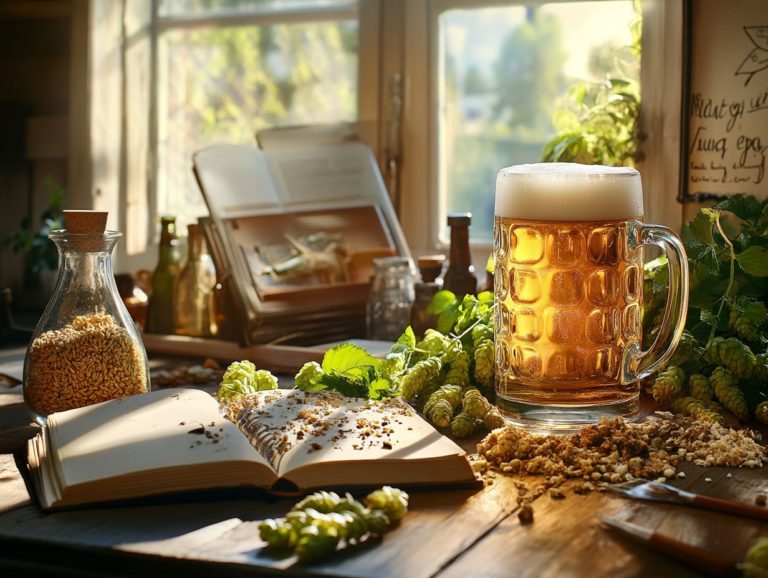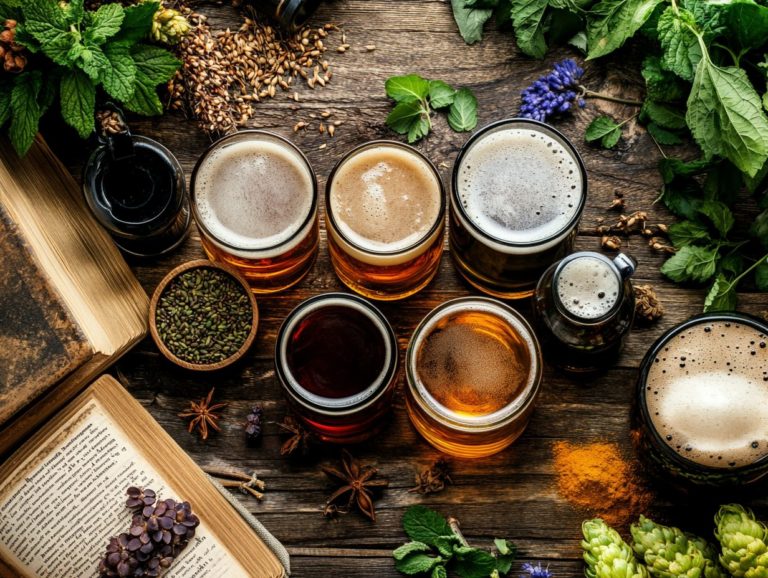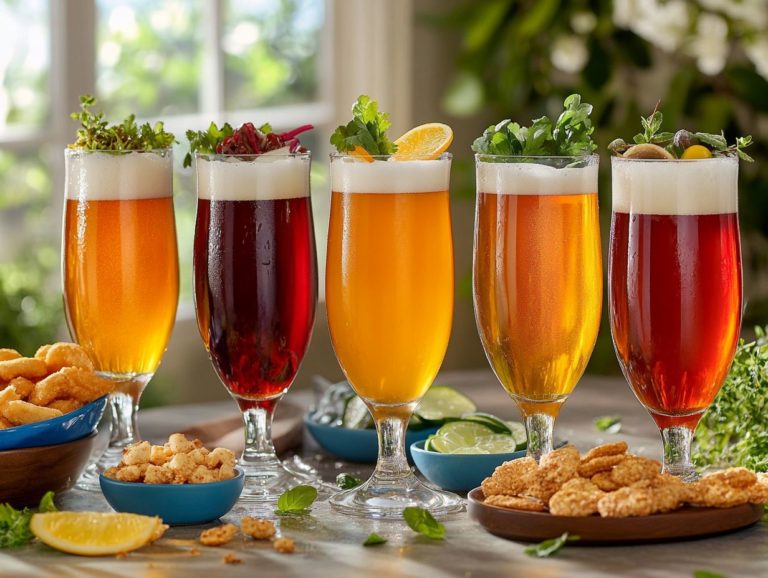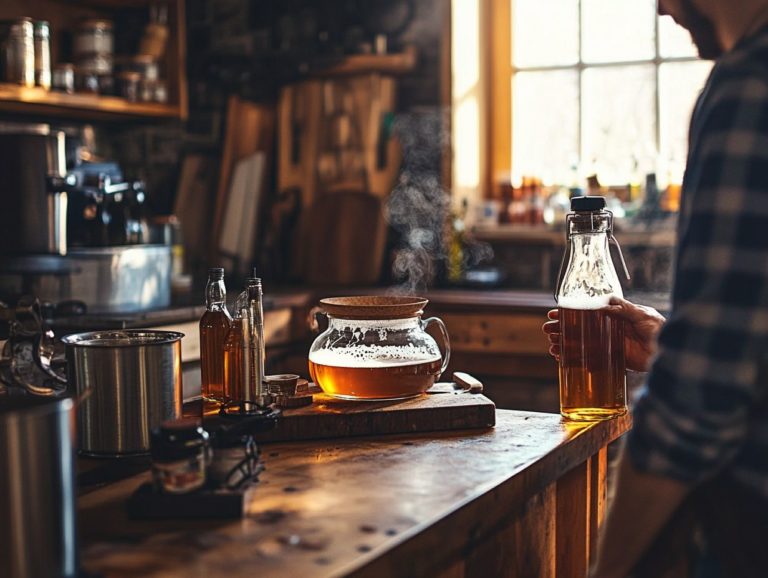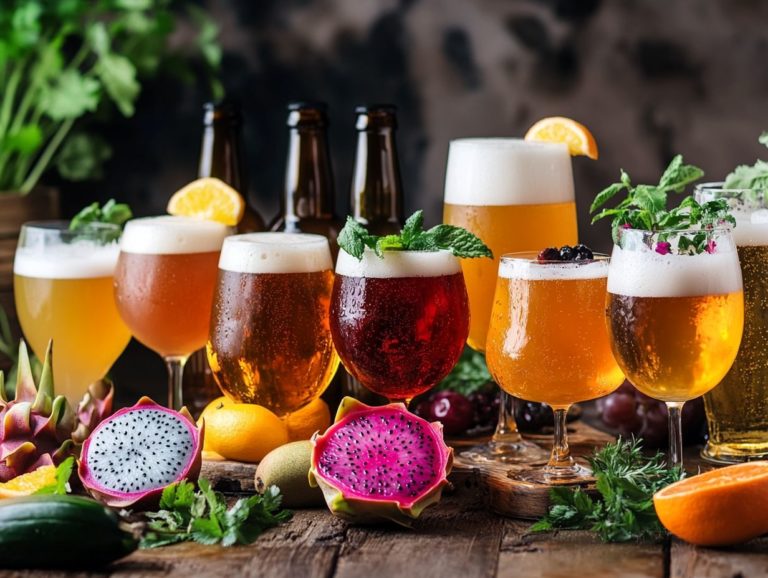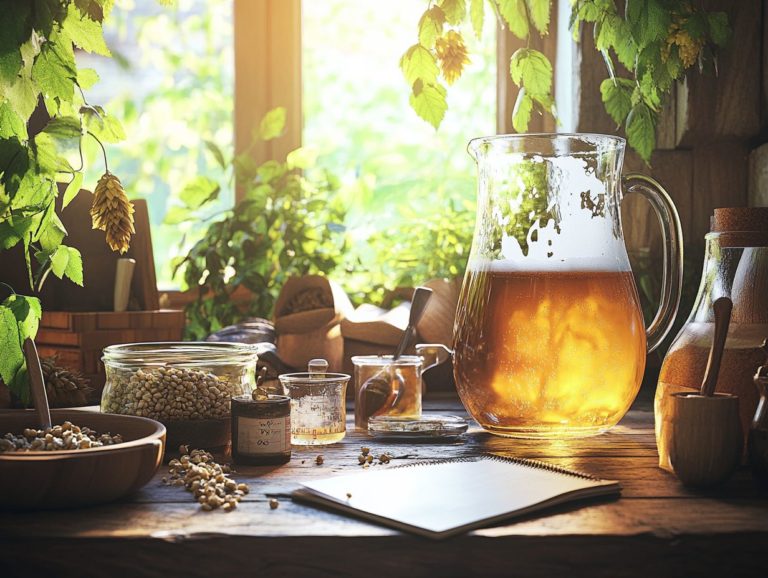Craft Your Own IPA: Step-by-Step Guide
If you’ve ever enjoyed a hoppy India Pale Ale (IPA) and found yourself captivated by its bold flavors and enticing aromas, whether it’s a Hazy IPA or a New England IPA, you’re in for something special.
This article invites you to embark on a journey through the fascinating realm of IPA brewing from its vibrant history and key ingredients to the intricate brewing process and unique brewing techniques that bring it all to life.
Whether you aspire to be a homebrewer or simply indulge in the delights of craft beer, get ready to discover exciting tips to craft your own unique IPA recipe, including the importance of selecting the right hop varieties and understanding water chemistry.
Get ready to dive deep into an exhilarating exploration of hazy beers, vibrant fruit flavors, and unique experiences!
Contents
- Key Takeaways:
- What is an IPA?
- The History of IPA
- Ingredients for Making IPA
- The Brewing Process and Brewing Tips
- Creating Your Own IPA Recipe
- Choosing Your Malt
- Selecting Your Hops
- 4. Calculating the ABV and IBU
- Equipment Needed for Brewing
- The Brewing Process Step-by-Step
- 1. Sanitizing Equipment
- 2. Mashing the Grains
- 3. Adding Hops
- 4. Fermentation and Carbonation
- Tips and Tricks for a Successful IPA
- Frequently Asked Questions
- What is an IPA and why should I craft my own?
- What equipment do I need to craft my own IPA?
- What are the key ingredients for crafting an IPA?
- How long does it take to craft an IPA?
- What are the basic steps for crafting an American IPA?
- Where can I find a step-by-step guide for crafting my own craft beer?
Key Takeaways:
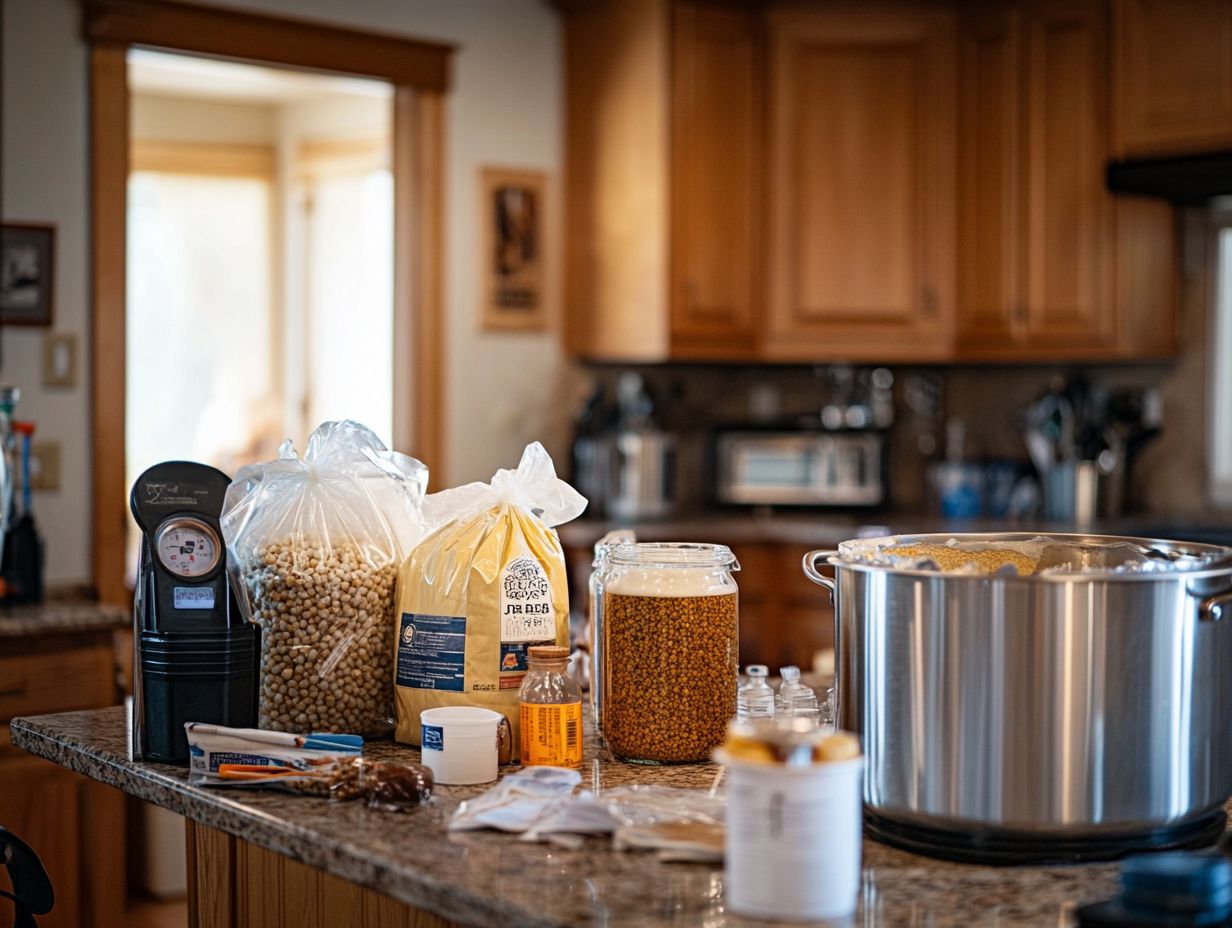
- Crafting your own IPA allows you to have full control over the flavors and characteristics of the beer.
- The history of IPA dates back to the 18th century and has evolved into a popular and diverse beer style.
- The key ingredients for making IPA include malt, hops, yeast, and proper water chemistry, which all play a crucial role in the beer’s flavor profile.
What is an IPA?
An IPA, or India Pale Ale, stands out as a quintessential style of craft beer, celebrated for its prominent hoppy character and enticing haziness.
It offers an array of vibrant fruit flavors. The hazy appearance of some IPAs, such as Hazy IPA and New England IPA, adds to their allure.
This beloved beer has branched out into an impressive selection of sub-styles, including Hazy IPA, New England IPA, and Juicy IPA. Each presents a distinctive tasting journey that captivates both beer aficionados and discerning judges in IPA competitions.
The artistry of brewing an IPA involves a meticulous selection of specific hop varieties and careful management of fermentation temperatures.
It also requires achieving a harmonious flavor profile that artfully balances malt, citrus notes, and other fruit hop flavors with a refined mouthfeel.
The History of IPA
The history of IPA traces back to the 19th century when British brewers embarked on a journey to craft pale ales with an elevated hop content. This clever strategy was designed to preserve the beer during lengthy sea voyages to India.
This style has evolved elegantly over the years, paving the way for American IPAs, which boast distinct brewing methods, including the use of brewing salts and specific hop additions that highlight bold hop flavors in delightful ways.
Craft breweries such as Tree House, Trillium, Hill Farmstead, and Tired Hands have been instrumental in elevating the IPA to a central role in the modern craft beer movement.
They showcase innovative techniques and intricate flavor profiles that are nothing short of inspiring.
Ingredients for Making IPA
Crafting a flavorful IPA demands a keen understanding of the essential ingredients that contribute to the brewing process, especially malt, hops, yeast, and water chemistry.
Each of these components is key to shaping the beer s overall flavor profile, mouthfeel, and aroma.
You ll want to select your grain bill with precision, considering various hop varieties like Citra, Mosaic, Simcoe, and Galaxy to infuse vibrant fruit hop flavors and a touch of bitterness.
This careful balance is what elevates your IPA, making it a standout choice for both craft beer enthusiasts and discerning judges.
1. Malt
Malt stands as one of the cornerstone ingredients in brewing an IPA, playing a vital role in shaping the beer’s color, body, and sweetness through the malt sugars that emerge from the grain bill. You’ll discover that different types of malt can deliver a spectrum of flavor profiles, ranging from a light, crisp character to a rich, caramel sweetness, all of which enhance the overall mouthfeel of the final product, much like the way oatmeal cookies add a unique texture.
The variety of malts you choose can profoundly influence not only the taste but also the visual allure and texture of the beer. For example, base malts like pale malt provide the essential sugars required for fermentation while contributing a lighter color. In contrast, specialty malts, such as crystal or caramel malts, enrich the flavor with delightful hints of toffee or chocolate, deepening the hue and adding a fuller body.
The mashing process is another pivotal stage in this transformation. During mashing, you mix the crushed grains with hot water, activating enzymes that convert starches into fermentable sugars. The temperature and duration of this process can be meticulously adjusted to optimize the extraction of flavors and sugars, enabling you to craft IPAs that reflect specific profiles tailored to your brewing vision.
2. Hops
Hops are arguably the crown jewel of an IPA, imparting a distinctive bitterness, aroma, and flavor spectrum that can take you from zesty citrus to lush tropical fruit notes. As you explore the brewing process, you’ll find that various hop varieties, like Amarillo and Galaxy, are expertly added at different stages, shaping the beer’s overall profile and character.
In the initial stages, bittering hops are introduced during the boil, laying down the essential bitterness that balances the sweet malt. Conversely, when you make those late hop additions often just before or after the boil you invite vibrant aromas that truly enhance the drinking experience. Techniques like whirlpooling and dry hopping, where hops are added during fermentation, maximize aromatic potential without introducing extra bitterness.
The selection and timing of these hops are pivotal; they significantly influence the final product, weaving a unique tapestry of flavors and scents that can whisk you away to sun-drenched orchards or verdant tropical landscapes.
3. Yeast
Yeast plays a pivotal role in the fermentation process of your IPA, skillfully transforming sugars into alcohol and adding depth to the beer’s character. The specific yeast strains you choose can impart unique flavors, making controlling the fermentation temperature essential for achieving a clean ale that beautifully showcases the hop and malt profiles.
Take American Ale yeast, for instance. It s a favorite among brewers for its ability to produce fruity esters and a clean finish, enhancing hop bitterness without overwhelming your palate. On the other hand, English Ale yeast brings a more malty flavor to the table, often contributing to a fuller mouthfeel that many enjoy.
In terms of fermentation techniques, remember that factors like temperature control and pitch rate significantly influence yeast performance. By maintaining a cooler fermentation temperature, you can help minimize unwanted byproducts, resulting in a crisper finish that elevates your brew.
Don’t overlook the importance of proper oxygenation before fermentation begins; it promotes healthy yeast activity and paves the way for a more robust flavor profile. Additionally, understanding the use of brewing salts and the role of carbon dioxide can further refine your brewing process.
The Brewing Process and Brewing Tips
The brewing process for an IPA is a meticulous journey that unfolds through several key stages, each playing a crucial role in shaping the final product. Understanding the basics of brewing equipment and brewing time is essential for crafting a perfect beer.
From mashing the grains to boiling the wort and fermenting with carefully selected yeast strains, every step influences the beer s flavor, aroma, and overall quality.
Grasping these brewing methods is essential for anyone aspiring to craft the perfect beer, whether at home or in a craft brewery.
Introduction
Crafting your own IPA can be an exhilarating experience, filled with creative choices and delicious outcomes. In this guide, we ll walk you through the essential steps of brewing, from mashing your grains to fermentation and hop addition. Master these techniques to craft an IPA that friends will rave about!
1. Mashing and Malt Sugars
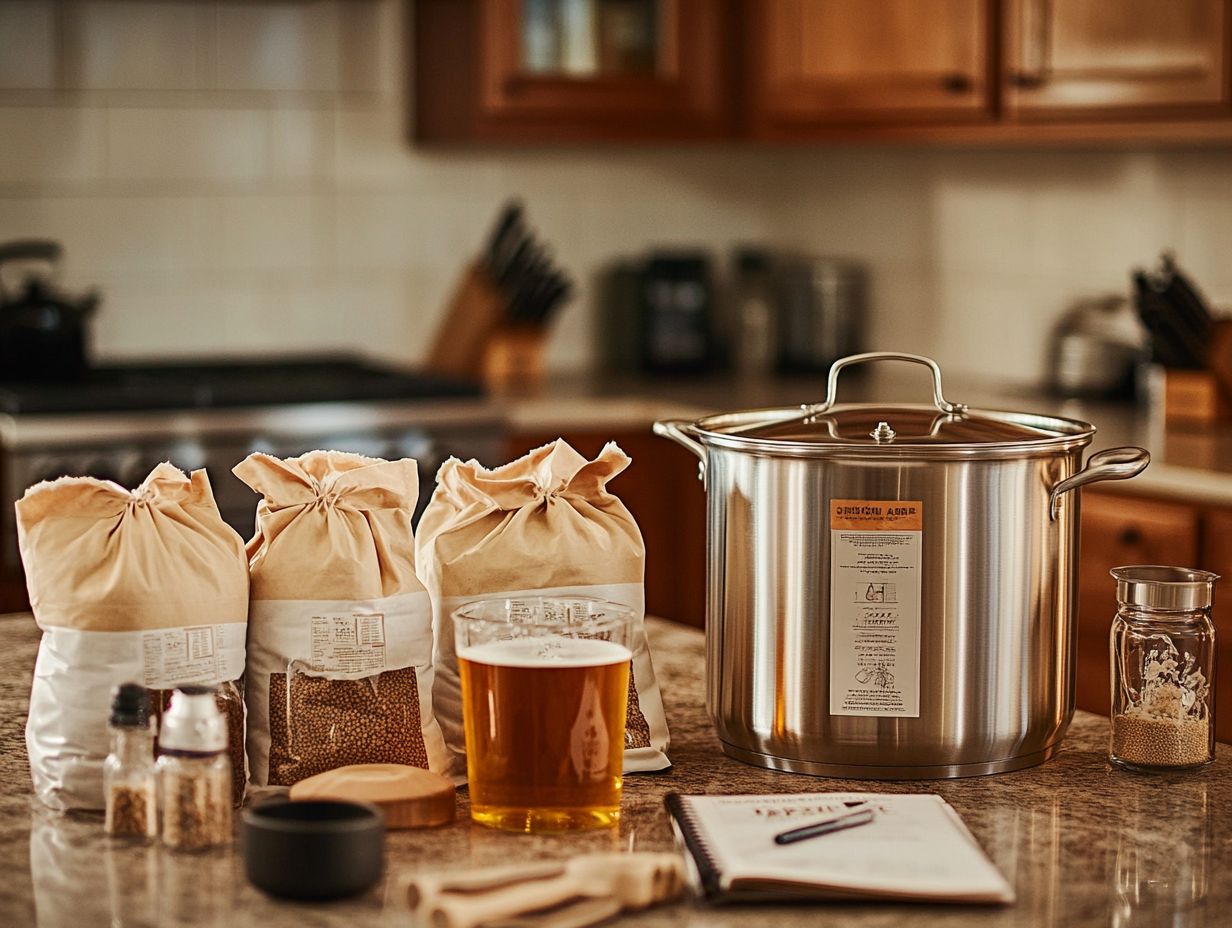
Mashing is an essential step in your brewing journey. Here, you combine crushed grains with hot water to activate enzymes that transform starches into fermentable malt sugars. This process extracts rich flavors and sets the stage for the final sweetness and body of your IPA, shaping its overall mouthfeel.
During mashing, you ll typically maintain a temperature between 148 F and 158 F (64 C to 70 C), with the duration ranging from 60 to 90 minutes. At these ideal temperatures, specific enzymes, like alpha-amylase (an enzyme that helps break down sugars) and beta-amylase (another enzyme involved in sugar breakdown), go to work, breaking down complex carbohydrates into simpler sugars.
The grain bill you choose is crucial, comprising various types of malts that play a pivotal role in this process. The unique characteristics of these grains will affect not just the sugar profile but also the color and flavor nuances of your final brew. For instance, using a higher proportion of crystal malts can introduce delightful sweetness and caramel notes, while roasted grains will impart darker, more robust flavors. These choices can significantly influence the beer color and its appeal in competitions.
Thus, mastering the mashing process is crucial for crafting a well-balanced IPA that captivates the palate, ensuring a clean ale with a balanced malt and hop profile.
2. Boiling and Hop Addition
Boiling is the pivotal stage where you heat the wort and introduce hops, infusing your IPA with the essential bitterness and aroma it craves. Timing is everything during this phase; the moment you add those hops can dramatically alter the bitterness and flavor complexities, ultimately shaping the beer s final taste profile. Carefully selecting hop varieties, like El Dorado and Amarillo, can enhance your brew.
As the wort bubbles vigorously under the heat, it enhances the extraction of vital oils from the hops, creating a symphony of flavors. You’ll want to time your hop additions carefully; early hops lay the groundwork for overall bitterness, while those added later are the secret to aroma and flavor. Techniques like whirlpooling and dry hopping elevate these characteristics, resulting in an aromatic, multidimensional brew. This careful hop charge can make all the difference in the final beer color and flavor complexity.
The length of the boil is just as critical, influencing the Maillard reaction and caramelization, which contribute depth and richness to your beer s final flavor. Each decision you make during this process helps craft a masterpiece in a glass.
3. Fermentation and Yeast Strains
Fermentation is a crucial stage in brewing your IPA, where yeast takes center stage, consuming the sugars extracted from the malt during mashing and transforming them into alcohol and carbon dioxide. Managing the fermentation temperature is crucial to your success, as it helps produce a clean ale that lets those hop flavors truly shine.
Choosing the right yeast strain is equally important, as each variety brings its own unique flavors and aromas, shaping the overall character of your beer. For example, American Ale yeasts are known for amplifying hop-centric profiles, while English yeasts might introduce a delightful malt complexity.
To keep things on track, maintaining an optimal fermentation temperature ideally between 65 F and 75 F is essential. This helps minimize unwanted off-flavors and supports a steady fermentation process. However, brewers like yourself can encounter challenges such as stuck fermentation or excessive esters, which can muddy the intended flavor profile.
By closely monitoring yeast health and ensuring proper aeration, you can navigate these obstacles and achieve the results you desire, ultimately enhancing the overall drinking experience.
4. Carbonation
Carbonation marks the final flourish in the brewing process, where carbon dioxide graces the beer with that delightful fizz and mouthfeel that discerning craft beer enthusiasts cherish. You can achieve this effervescence through either natural fermentation or forced carbonation methods, each bringing its own set of advantages.
With natural fermentation, you introduce priming sugar before bottling. This allows the yeast to work its magic by converting that sugar into additional carbon dioxide. This method not only elevates the fizz but also infuses the beer with added complexity. You get a hint of yeast character in the flavor profile.
In contrast, forced carbonation entails pumping CO2 directly into the keg, resulting in a remarkably consistent and predictable level of fizziness an essential factor, especially for IPAs.
The carbonation level is pivotal in enhancing the beer’s aroma, as the bubbles work to liberate aromatic compounds, significantly influencing your overall tasting experience. For those of you striving for the perfect carbonation, experimenting with different levels typically ranging from 2.2 to 2.8 volumes of CO2 will help you strike that ideal balance between texture and flavor.
Creating Your Own IPA Recipe
Are you ready to embark on the thrilling adventure of crafting your own unique IPA? Crafting your own IPA recipe is an exhilarating journey that invites you to delve into a world of brewing techniques and ingredients, allowing you to create a distinctive beer that perfectly aligns with your taste preferences.
From selecting the ideal malt types to choosing the right hop varieties and yeast strains, the options are virtually limitless. By grasping the fundamental elements of the brewing process, you can design a beer recipe that embodies your ultimate flavor profile and delivers the experience you desire.
Choosing Your Malt
Choosing the right malt is essential for your IPA recipe, as it profoundly influences the beer’s flavor profile, color, and body. Take a moment to explore the various malt types available light, caramel, or roasted and consider how they will harmonize with the hop varieties you plan to incorporate into your brew.
Malt selection forms the foundation for a balanced brew, with each type offering its own unique characteristics. Light malts typically provide a clean and crisp backbone, allowing the vibrant hop flavors to take center stage. On the other hand, caramel malts introduce sweetness and complexity, enhancing the overall mouthfeel of your creation.
When used judiciously, roasted malts can add subtle chocolate or coffee notes, creating intriguing layers of flavor. It’s crucial to achieve harmony in your grain bill; too much malt sweetness can overpower the bitterness and aroma of your hops. Aim for a thoughtful combination that not only delights the palate but also elevates the hop profile, inviting drinkers to relish every sip of their IPA.
Selecting Your Hops
Selecting the right hops is a pivotal decision in crafting your IPA. Different hop varieties offer a fascinating array of flavor complexities, from bright citrus and tropical fruit to rich earthy and floral aromas. By experimenting with various hops, you can achieve that perfect balance of bitterness and aroma that defines your brew.
Among the most popular hop varieties, Citra and Mosaic stand out for their vibrant citrus notes, while Simcoe lends a more piney and earthy character. When planning your hop additions, finding the right balance is crucial. Consider adding some hops earlier in the boil to build bitterness, while reserving others for the final stages to enhance the aroma.
Don’t overlook the technique of dry hopping; by adding hops during fermentation, you can amplify those fragrant qualities without ramping up bitterness, resulting in a well-rounded and aromatic IPA. Feel free to mix and match each batch you create could unveil unexpected treasures waiting to be savored.
Now it’s time to gather your ingredients and start brewing your masterpiece! Start brewing today and discover your signature IPA!
3. Picking Your Yeast
Choosing the right yeast strain is crucial in your quest to craft the perfect IPA, as it profoundly influences the fermentation process and the resulting flavors in your brew. Different yeast strains can impart unique fruity or clean profiles, so think carefully about how they will interact with the malt and hops you’ve selected.
If you’re aiming for a juicy New England-style IPA, choose a yeast strain known for its fruity esters. A hazy yeast can elevate those vibrant citrusy hop notes.
On the other hand, if a classic West Coast IPA is on your agenda, a traditional American ale yeast might be your best bet, allowing the bitterness and hop character to shine without overwhelming the malt backbone.
When selecting your yeast strain, it’s equally important to consider the fermentation temperature, as this factor can significantly impact the esters and phenols produced during the process. Keeping temperatures within the recommended range will help you achieve a desirable balance, enhancing the unique characteristics of your chosen IPA style.
4. Calculating the ABV and IBU
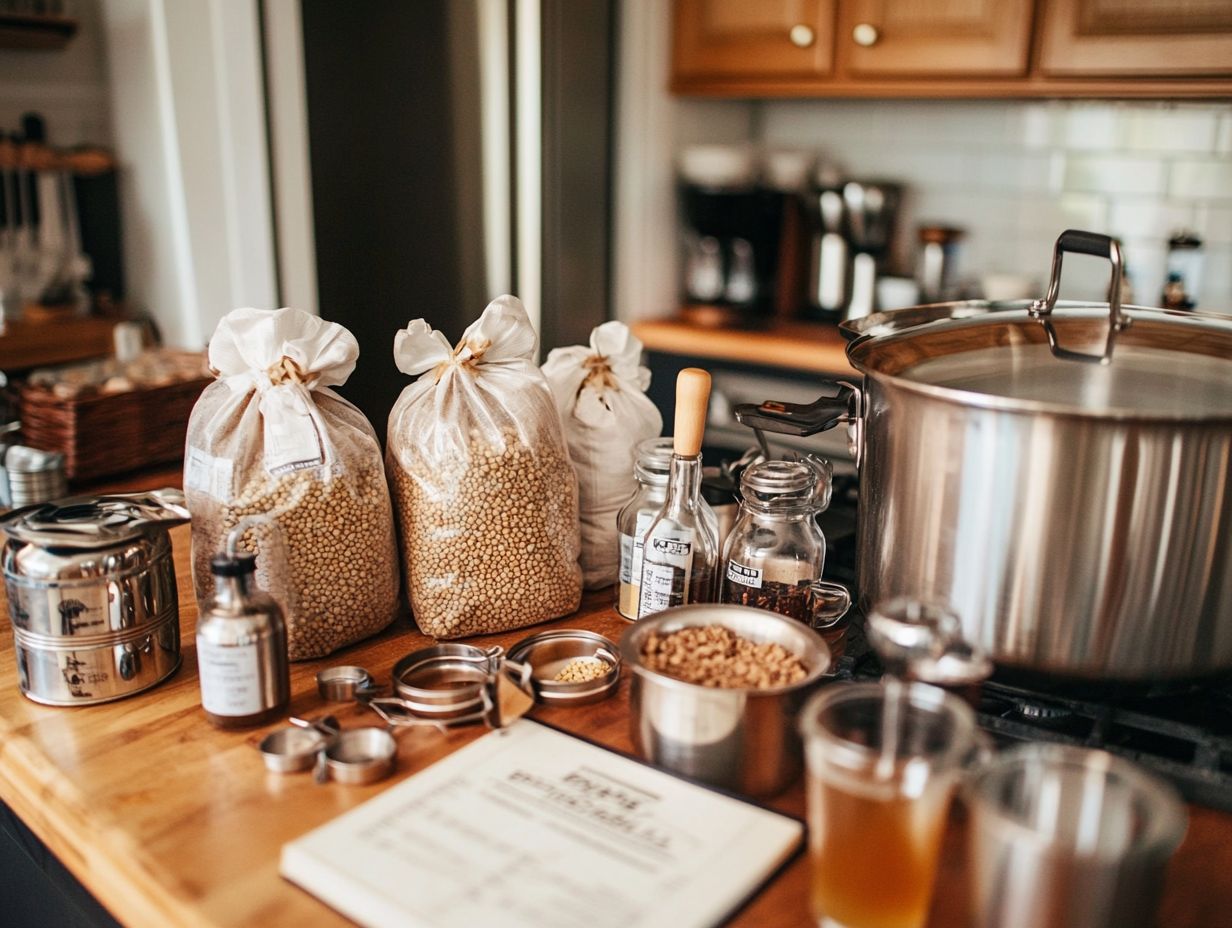
Calculating the Alcohol by Volume (ABV) and International Bitterness Units (IBU) is crucial for crafting a well-balanced beer recipe, as these metrics define the strength and bitterness of your IPA. By mastering how to achieve your desired levels of ABV and IBU, you ll be able to fine-tune your flavor profile to perfectly match your taste preferences.
In brewing, you calculate ABV by measuring the amount of alcohol produced during fermentation as a percentage of the total liquid volume, which gives you valuable insight into the beer’s potency. Similarly, IBU quantifies the bitterness derived from hop content, playing a critical role in achieving the right flavor balance.
For those aiming for the optimal IPA, experiment with different hop additions during both the boil and dry-hopping stages; this enhances aroma while managing bitterness. Monitor the fermentation temperature closely to influence the final ABV, ensuring your craft beer aligns seamlessly with your vision.
Equipment Needed for Brewing
Having the right brewing equipment is key to your success! This equipment will help with every step of the brewing process, from mashing to fermentation.
By investing in high-quality brewing tools, you not only elevate your brewing experience but also significantly enhance your chances of creating the perfect beer that reflects your unique brewing style.
1. Brew Kettle
A brew kettle is an essential piece of equipment in your brewing process, serving as the vessel where you boil the wort and add hops to impart that all-important flavor and bitterness. The size and material of your brew kettle can directly influence both your brewing efficiency and the quality of the final product.
You ll find various types of brew kettles available, each tailored for specific brewing needs and capacities, whether you re crafting small home batches or managing larger commercial operations. For example, stainless steel kettles are often preferred for their durability and exceptional heat retention, while aluminum kettles provide lightweight convenience and affordability.
The capacity of your brew kettle plays a significant role in determining how much beer you can produce at once. Larger kettles enable more extensive brewing sessions, which is particularly advantageous if you’re planning to scale up your production. Ultimately, making the right choice in brew kettles enhances your temperature control and ensures that all ingredients are thoroughly mixed, significantly impacting the overall flavor profile and quality of your beer.
2. Fermentation Vessel
The fermentation vessel is where the magic unfolds in brewing, providing the perfect environment for yeast to thrive and transform sugars into alcohol. Choosing the right vessel is essential for controlling temperature and monitoring fermentation, ensuring you achieve exceptional results.
You’ll find various fermentation vessels crafted from materials like glass, plastic, stainless steel, or ceramic. Glass carboys are a favorite among homebrewers due to their non-reactive qualities. Plastic fermenters are lightweight and often come with convenient taps that make pouring easy. Stainless steel is valued for its durability and easy cleaning, making it an excellent choice for larger batches, especially if you’re brewing a Hazy IPA or New England IPA.
When selecting a vessel, consider factors such as batch size, fermentation type, and your budget. This choice impacts the brewing process and significantly influences the final flavor, hazy appearance, and quality of your beer.
3. Bottling Bucket
A bottling bucket is a critical tool for transferring your finished beer into bottles, ensuring your brew is free from sediment and perfectly carbonated. This tool makes your bottling process quick and efficient, especially if you’re preparing for an IPA competition.
With its built-in tap, the bottling bucket allows you to easily dispense your beer, significantly reducing the risk of oxidation or contamination. As an enthusiast, you’ll appreciate how this tool preserves the flavor integrity of your brew, especially if you’re making a Juicy IPA, while saving you time and effort during bottling.
Make sure to sanitize all your equipment before you start; it’s vital for the best results! Fill your bottles from the bottom upwards to minimize foam and overflow. Using a consistent filling method ensures each bottle has the same level of carbonation, resulting in a more uniform tasting experience.
4. Bottles and Caps
Bottles and caps are the final touches in packaging your craft beer, playing a crucial role in preserving freshness and carbonation. Choosing the right types of bottles and caps prevents oxidation and contamination, ensuring the quality of your finished IPA.
As you explore homebrewing, understand the differences between bottles designed for carbonated and non-carbonated beers. Standard brown glass bottles are often the preferred choice for carbonated beverages, offering optimal light protection. If you’re brewing non-carbonated varieties, plastic bottles can work, but they tend to allow more oxygen to seep in.
Investing in high-quality caps is paramount. They create a secure seal and help retain carbonation, ensuring every sip delivers the flavor you intended. Proper capping enhances the overall drinking experience and highlights the artistry that goes into each batch, especially if you’re aiming for recognition in a beer competition.
The Brewing Process Step-by-Step
The brewing process unfolds through several essential steps, each requiring specific techniques and keen attention to detail to achieve a high-quality IPA. From selecting the right hop varieties, like Mosaic or Simcoe, to accurately managing fermentation temperature, every detail matters.
From thoroughly sanitizing your equipment to expertly mashing the grains, and from precise fermentation to achieving the ideal carbonation, every stage plays a crucial role in creating a beer that embodies your unique brewing style. Whether you’re brewing a Hazy IPA or a traditional American IPA, attention to detail is key.
1. Sanitizing Equipment
Sanitizing your equipment is an essential first step in the brewing process, as it effectively eliminates unwanted bacteria and wild yeast that could spoil your carefully crafted IPA. By employing proper sanitizing methods, you ensure that your brewing gear is not only safe but primed for success, leading to a flawless fermentation. Ultimately, this will result in a beer that could impress beer judges.
Investing the time to sanitize properly, utilizing chemicals like iodine or Star San, safeguards the integrity of your brew and instills confidence in the final product. It s imperative to give everything a thorough rinse after applying these sanitizers to remove any lingering residues.
Equally crucial is maintaining a pristine brewing environment. Always clean surfaces before starting, store your ingredients in sanitized containers, and ensure that all your tools are disinfected after each use. Embracing these practices not only preserves the rich flavors of your brew but also minimizes the risk of infection. This grants you better control over the entire brewing process.
2. Mashing the Grains
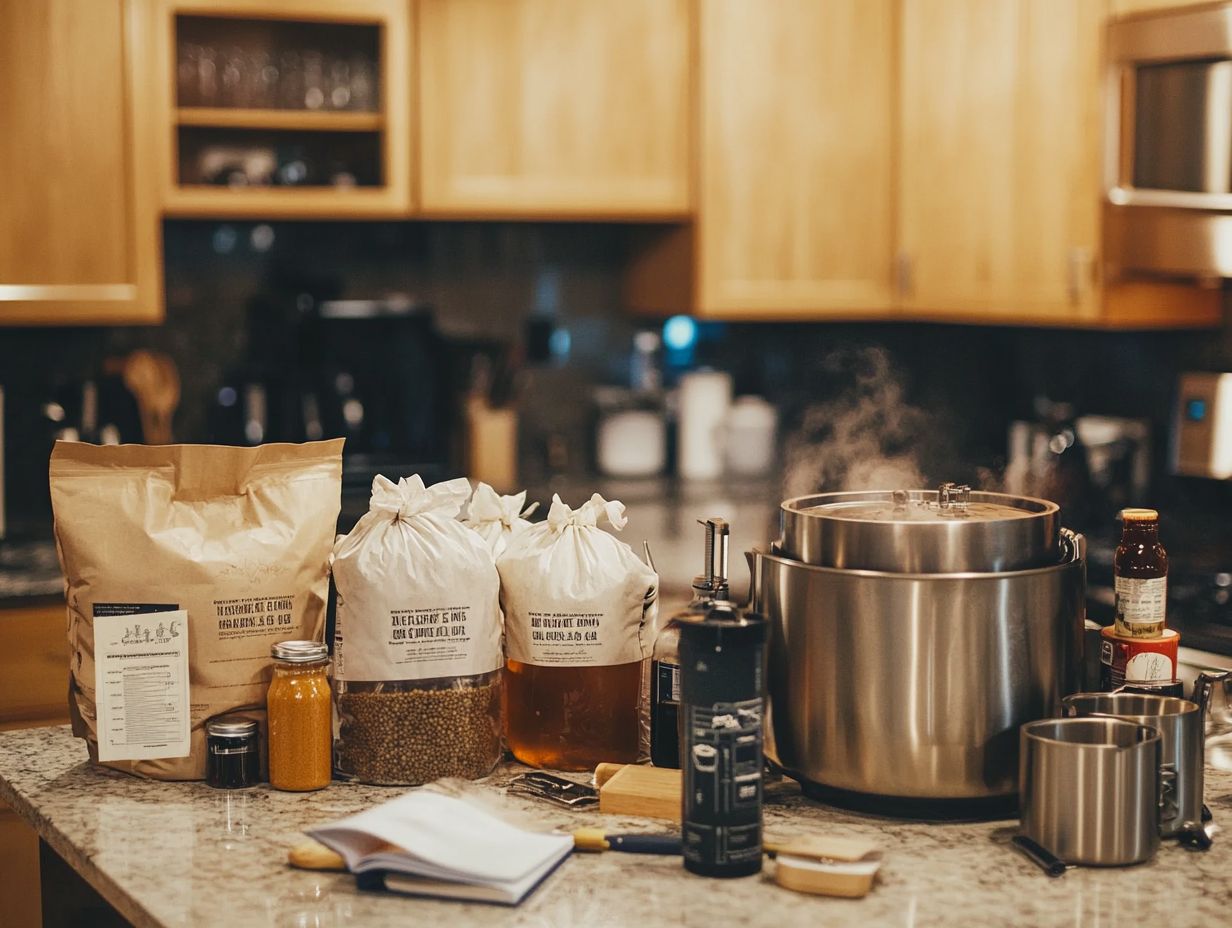
Mashing the grains is the next critical step in your brewing journey. Here, you combine crushed malt with hot water to activate enzymes that convert starches into fermentable malt sugars. This phase is essential for extracting the flavors and sugars that will ultimately define the character of your IPA, including its mouthfeel and malty flavor.
During this process, you steep the crushed grains in water at carefully monitored temperatures, usually between 150 F and 156 F (65 C to 69 C). By maintaining this temperature for around 60 minutes, you allow enzymes, primarily amylase (an enzyme that breaks down starches), to work their magic. They break down complex carbohydrates into simpler sugars. The choice of grains, or grain bill, can significantly influence the flavor profile and beer color.
Feel free to make adjustments based on the body and sweetness left in the beer you desire in your final product. For example, a protein rest at a lower temperature (approximately 130 F or 54 C) can enhance mouthfeel. Conducting a mash-out at higher temperatures will halt enzymatic activity and improve sugar extraction. Using brewing salts can help fine-tune your water chemistry for optimal results.
Monitor pH levels and utilize appropriate water profiles. These factors can further refine your mashing process and ensure you achieve a well-balanced beer with rich, captivating flavors.
3. Adding Hops
Adding hops is a pivotal moment in your brewing process, where the wort is infused with essential oils and flavors that lend your IPA its distinctive character. The timing and selection of hop varieties you choose, such as Citra, Galaxy, or Amarillo, will greatly influence both the bitterness and aroma, ultimately shaping the final flavor profile.
Throughout your brewing journey, the stages for adding hops can significantly alter the taste and fragrance of your beer. Add bittering hops early in the boil to establish the foundational bitterness that balances out the malt sweetness.
As the process unfolds, late additions bring in aroma hops, unleashing a delightful bouquet of citrus, pine, or floral notes that elevate the complexity of your creation. Different hop varieties, such as Cascade, Simcoe, or El Dorado, can have a dramatic impact on the final result. So, it s essential to balance these additions with care.
Brewers like you often experiment with various combinations to achieve that perfect harmony of flavors, making each batch a unique expression of your craft. Techniques like dry hopping can further enhance the fruit hop flavor and aroma of your IPA.
4. Fermentation and Carbonation
Fermentation and carbonation mark the final stages in your brewing process. Here, yeast diligently converts sugars into alcohol while producing carbon dioxide, infusing your beer with delightful fizz. Managing fermentation conditions with precision is essential for crafting a clean and flavorful IPA.
Choosing the right yeast strains and maintaining an ideal fermentation temperature are crucial in this stage. The success of this phase relies on several key factors, starting with your choice of yeast strain. This decision can dramatically influence flavor profiles and fermentation efficiency.
Temperature control is equally important. Different yeast varieties perform best at specific temperatures, affecting the fermentation rate and the production of esters and phenols. The right brewing water composition also significantly impacts your brew.
As a brewer, you must meticulously monitor carbonation levels. Employ natural methods like priming sugar or forced carbonation to achieve your desired results. Regularly checking these elements ensures that your final product aligns with your vision and meets the high standards expected by discerning beer enthusiasts. Properly managing carbon dioxide levels is key to achieving the perfect beer.
Tips and Tricks for a Successful IPA
To craft a successful IPA that truly distinguishes itself in the vibrant world of craft beer, embrace specific tips and techniques throughout the brewing process. Whether you’re aiming for a hazy appearance, a strong citrus flavor, or a balanced malty flavor, the right brewing techniques make all the difference.
By carefully selecting the finest ingredients and mastering fermentation methods, you will elevate your brewing game and create a beer that beautifully embodies your unique style and vision. Drawing inspiration from renowned breweries like Tree House and Trillium can provide valuable insights.
Frequently Asked Questions
What is an IPA and why should I craft my own?
An IPA, or India Pale Ale, is a hoppy, bitter beer style that has gained popularity in recent years. When you craft your own IPA, you can pick the ingredients to create a flavor that s just right for you!
What equipment do I need to craft my own IPA?
To craft your own IPA, you will need basic brewing equipment such as a large pot, thermometer, fermenter, and bottling equipment. Specific equipment for brewing beer, such as a mash tun, wort chiller, and dry hopping tools, is also necessary.
What are the key ingredients for crafting an IPA?
The key ingredients for crafting an IPA are water, malted barley, hops, and yeast. Specialized IPA recipes may also call for additional ingredients such as specialty grains, sugars, or fruit. For a Juicy IPA or Hazy IPA, consider using oats or wheat to enhance the mouthfeel.
How long does it take to craft an IPA?
The total time to craft an IPA can vary, but on average, it takes about 4-6 weeks. This includes the time for brewing, fermenting, and carbonating the beer. However, the brewing time can differ depending on the specific beer recipe and techniques used.
What are the basic steps for crafting an American IPA?
The basic steps for crafting an IPA include creating a beer recipe, brewing the wort, fermenting the beer at the correct fermentation temperature, and bottling or kegging the finished product. Pay attention to the brewing process, including dry hopping and selecting the right hop varieties like Citra, Galaxy, Mosaic, Simcoe, and Amarillo. More detailed steps and instructions can be found in a step-by-step guide for crafting your own Hazy IPA or New England IPA, ensuring you achieve the desired hazy appearance and juicy IPA mouthfeel.
Where can I find a step-by-step guide for crafting my own craft beer?
You can find step-by-step guides for crafting your own IPA online, in brewing books, or by attending a home brewing class. It is important to follow a reliable and detailed guide to ensure the best results for your homemade IPA. Look for tips on water chemistry, grain bill, brewing salts, and brewing techniques to perfect your beer. Exploring different yeast strains, malt sugars, bittering hops, and hop additions can enhance the flavor profile, including fruit flavors like citrus and malty flavors, creating unique experiences.

